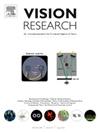图像、运动和双眼线索对深度和距离感知的贡献
IF 1.4
4区 心理学
Q4 NEUROSCIENCES
引用次数: 0
摘要
有多种视觉线索可用来估计距离。根据改进的弱融合模型,对这些线索信息进行加权平均,权重由每个线索的相对可靠性决定。该模型的实证检验倾向于孤立少量线索,以便对其可靠性进行操纵。以这种方式测量的权重是特定于测试环境的,并且不允许我们量化单个线索在自然观看中的贡献。为了解决这个问题,我们从文献中对广泛距离线索的敏感性进行估计,以预测图像、双目和运动线索对相对距离的贡献。评估的线索包括收敛、调节、视场高度、纹理密度、相对大小、视场高度、双眼视差和运动(假设是行走的观察者)。我们使用改进的弱融合模型来估计双眼、运动和图像线索对2至100米距离的贡献。这些计算提供了个人深度线索在日常观看条件下的预期贡献的估计。在大多数情况下,我们的研究结果表明,与单独使用最可靠的球杆相比,在自然环境中使用加权平均球杆有明显的好处。本文章由计算机程序翻译,如有差异,请以英文原文为准。
The contributions of pictorial, motion, and binocular cues to the perception of depth and distance
Multiple visual cues are available for the estimation of distance. According to the modified weak fusion model, the information from these cues is combined through weighted averaging, with the weights determined by the relative reliability of each cue. Empirical tests of this model tend to isolate a small number of cues, in order for their reliabilities to be manipulated. Weights measured in this way are specific to the testing environment, and do not allow us to quantify the contributions of individual cues in natural viewing. To address this, we used estimates from the literature of sensitivity for a wide range of distance cues to predict the contribution of pictorial, binocular, and motion cues to relative distance. The cues assessed included convergence, accommodation, height in the field, texture density, relative size, height in the field, binocular disparity, and motion (assuming a walking observer). We used the modified weak fusion model to estimate the contribution of binocular, motion, and pictorial cues for distances between 2 and 100 m. These calculations provide estimates of the expected contributions of individual depth cues in everyday viewing conditions. In most cases, our results show a clear benefit for the weighted averaging of cues in the natural environment, in comparison with the use of the most reliable cue alone.
求助全文
通过发布文献求助,成功后即可免费获取论文全文。
去求助
来源期刊

Vision Research
医学-神经科学
CiteScore
3.70
自引率
16.70%
发文量
111
审稿时长
66 days
期刊介绍:
Vision Research is a journal devoted to the functional aspects of human, vertebrate and invertebrate vision and publishes experimental and observational studies, reviews, and theoretical and computational analyses. Vision Research also publishes clinical studies relevant to normal visual function and basic research relevant to visual dysfunction or its clinical investigation. Functional aspects of vision is interpreted broadly, ranging from molecular and cellular function to perception and behavior. Detailed descriptions are encouraged but enough introductory background should be included for non-specialists. Theoretical and computational papers should give a sense of order to the facts or point to new verifiable observations. Papers dealing with questions in the history of vision science should stress the development of ideas in the field.
 求助内容:
求助内容: 应助结果提醒方式:
应助结果提醒方式:


